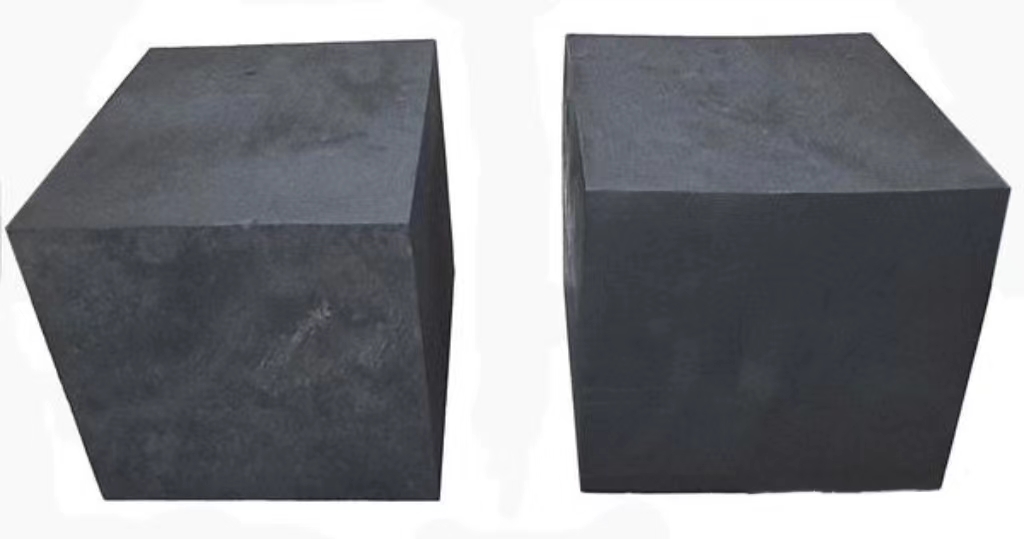Molded graphite is to put the blank in the shape of powder, granular, granular, flake, etc. in the cavity of the heated mold, then close the mold and press it up and down to compact it, and then demold it to get the product.
Table of Contents
ToggleMolded graphite is particularly good in density, electrical conductivity, mechanical strength, friction resistance, etc. We can also improve these properties by impregnating it with resin or metal.
Molding process
Generally divided into cold molding and hot molding.
For example, the production of pre-baked anodes block is mainly hot molding. The mixed paste is cooled and added to the molding mold, and bidirectional pressure is applied.
Cold molding is used to produce electric carbon products or cold-pressed graphite. Multiple pressurization can increase the density of the product.
Process of manufacturing molded graphite
-Selection and preparation of raw materials
Firstly, selecting and preparing raw materials to produce molded graphite.Typically, graphite is produced from petroleum coke and pitch. Coke is a fuel that is widely used in industry, while pitch could act as a binding agent.Before starting the manufacturing process, the industry will select high quality of coke and soil and store them in large store soil to get ready for production.
-Crushing
After the raw material are ready, then use crusher and mills to crushing and breaking these raw materials down into small powders to be easily to manufacture.
-Mixing
After crushing and pulverizing, holding these two particles together in the shaping and heating processes with precise ratios is imperative for manufacturing molded graphite at the start. Once finishing the mixture, molding them under high pressure and forms a solid block.
-Carbonization
After forming the solid block, put it in a high-temperature furnace to do carbonization afterwards. During the carbonization process, removing any volatile substances, transforming the pitch and coke together into a solid carbon structure. The temperature for carbonization typically ranges from 1000 to 1200°C, with controlled heating rates to prevent structural deformation.
-Converting to crystalline graphite structure
When the carbonization process finish, the carbonized block is then heated into high temperatures, usually above 2500°C. Heating the block to convert the carbon structure into a crystalline graphite structure and be ready for test.
-Testing
Finally, testing the molded graphite to ensure it complies with the quality standard. To test for the molded graphite, it involves several measures such as “Density, Average grain size, Specific resistance, Flexural Strength, , Coefficient of thermal expansion, Total ash content and Gas permeability.” After these all meet the standards, it is ready to use.
Features and Application
The characteristics of molded graphite products are: good conductivity, high temperature resistance, corrosion resistance, high purity, self-lubrication, thermal shock resistance, isotropy, and easy precision.
-Chemical Resilience and High Purity
Firstly, it is resistant to most acids and bases, making it become suitable for use in chemical industries. Its high purity ensures minimal contamination, and being widely used in semiconductor manufacturing.
-Thermal stability and density
Secondly, its feature of thermal stability and density could let molded graphite to endure high-stress environments. Being able to endure high-stress environments could make it resistant to deformation and cracking, even under significant mechanical and thermal stress. It is used in the continuous casting process and does not deform at high temperatures, ensuring the consistency of the continuous casting products.
-Electrical conductivity
Thirdly, Iso molded graphite is an excellent conductor of electricity, making it ideal for applications such as electrodes in electrical discharge machining (EDM) and as anodes in various electrochemical processes.
-Easy to machine
Finally, Molded graphite is relatively easy to machine, allowing for precise shaping and customization according to specific industrial requirements. This feature is particularly beneficial in fields requiring highly detailed components, such as in the production of aerospace parts.
Molded graphite vs extruded graphite
-Uniform structure difference
According to the creation of molded graphite through pressing the raw materials into a mold under high pressure. This results in uniform density and structure. This is much more stable than extruded graphite, which is pressed through a die into long bars or tubes. This results in a less uniform structure compared to molded graphite. Therefore, if the industry has higher requirements, such as brushes for motors, sealing materials, etc., molded graphite is better than extruded graphite.
-Cost and efficiency
Second difference is the issue of cost and efficiency. According to the manufacture of molded graphite requires complex process and the requirement of massive quality control test. The creation of molded graphite will often results in high cost and time consuming. On the other hand, the manufacture process of extruded graphite are often fast and less costly. That makes it a more economical choice for applications with less stringent structural and performance requirements. Thus, molded graphite are generally much more expensive compare to extruded graphite, and cost would be one of the important consideration that industry need to consider.
-Thermal and electrical properties
Furthermore, thermal and electrical properties are also a key difference. Because molded graphite has a dense structure and uniform density, it has consistent thermal and electrical conductivity. Making it highly reliable for applications where stable performance is essential. On the other hand, although extruded graphite has good thermal and electrical conductivity, its direction dependence may lead to inconsistent heat flow and electric current. As a result, molded graphite are much better in thermal and electrical conductivity compare to extruded graphite.
Conclusion
Molding method is used to press products with similar length, width and height. Products with uniform density and dense structure are required, such as carbon brushes for electrodes, graphite parts for vacuum devices, sealing materials, etc.

